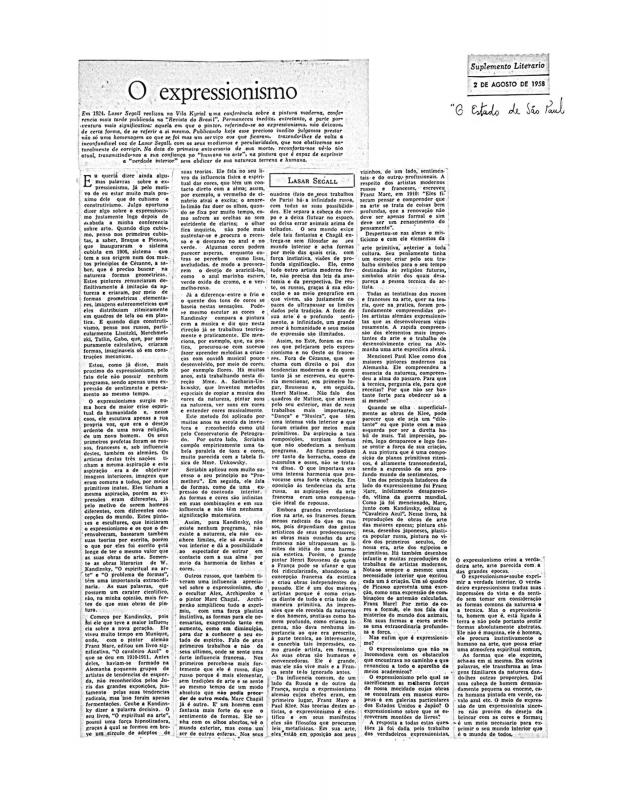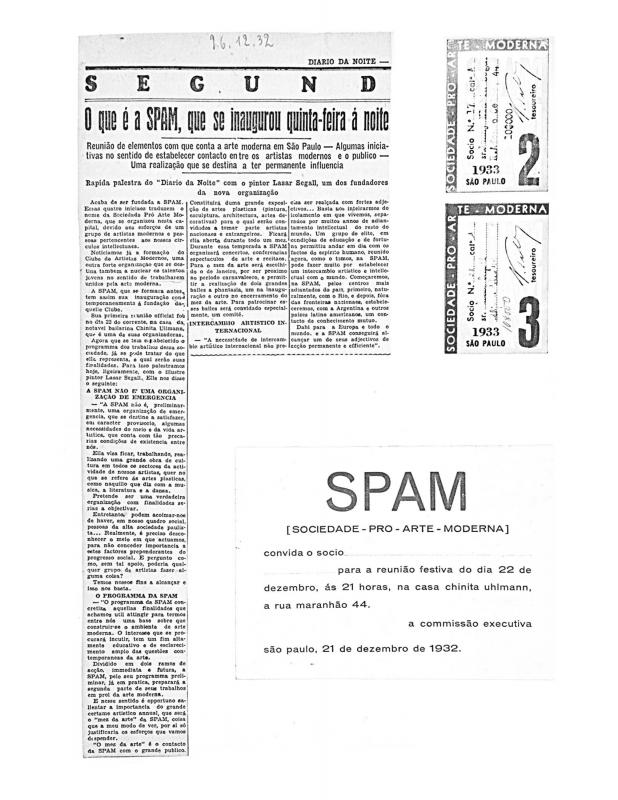What Lasar Segall refers to as “Jewish content” appears in his work at various stages throughout his career, from his prints about pogrom victims (beginning in 1910) to his depictions of Nazi concentration camps (1945), as well as in works such as Festa religiosa [Religious Festival] (1920) and the series Folhas comemorativas [Memorial Leaves] (1922). In Brazil, Segall was the target of anti-Semitic activities of the kind that were widespread throughout the country during the Estado Novo imposed under the regime of Getúlio Vargas (1937–45). For example, he was expelled from SPAM (Sociedade Pró-Arte Moderna)—the pro-modern art association that he cofounded in 1932—as a result of the ethnic-religious prejudices of certain members of the group. They were members of the socio-economic elite of São Paulo who supported the Movimento Integralista, a movement led by the conservative Catholic Plínio Salgado. The movement was a Brazilian version of Nazi youth groups; its members wore khaki fatigues and identified themselves with the mathematical summation “∑” sign (rather than a swastika), like the Fascist militants known as “Fascios,” and with reference to the mathematical integral.
Lasar Segall (1891–1957) was born in Vilnius, Lithuania, where his family was part of the Jewish community. He enrolled in the School of Applied Arts in Berlin and, in the early years of the century, spent time at the Academy of Fine Arts. In 1912 he travelled to Brazil, where his brothers were already living. The Centro de Ciências e Artes de Campinas (São Paulo) bought one of his paintings: Cabeça de menina russa (1908). He returned to Europe during the First World War. Joining forces with a group of German painters (such as Otto Dix) he co-founded the Dresdner Sezession – Gruppe 1919. After an exhibition of Russian art in Hanover in 1921 he established a relationship with Kandinsky. In 1923 he returned to Brazil. He painted a mural at the Pavilhão de Arte Moderna, a meeting place for artists and intellectuals at the home of the great promoter of the Semana de Arte Moderna of 1922, Mrs. Olivia Guedes Penteado. The mural was reviewed by Mário de Andrade, who identified his “Brazilian phase” (1924–28). Segall took part in SPAM’s Primeira Exposição de Arte Moderno and the Spamolândia project in 1934. Three of his paintings and seven prints were featured in the Entartete Kunst Ausstellungsführer [Exhibition of Degenerate Art] organized by the Nazis in Munich in 1937 to discredit modern art. In the 1940s Segall traveled, painted stage sets, and illustrated books and magazines. His major work, Navio de emigrantes (1939–41), was highly praised by George Grosz.
For more information on this painter’s essays about art in Brazil, see the lecture “O Expressionismo” [doc. no. 783352] and the interview “O que é a SPAM, que se inaugurou quinta-feira à noite” [doc. no. 783486].
The noted critic, poet, musicologist, and cultural promoter Mário de Andrade (1893–1945) closely followed Segall’s career in Brazil, writing several articles outlining what he described as the painter’s “visual art biography” during the time he lived in Brazil [doc. no. 783393]. He also introduced the album of drawings of the work Mangue produced by Segall [doc. no. 1111411].
There was also a great deal of interest in the 82 pages devoted to him in the “Revista Acadêmica: número de homenagem a Lasar Segall” [doc. no. 1110322] and a critical essay by Abilio Álvaro Miller, “Um pintor de almas” [doc. no. 1084988].






